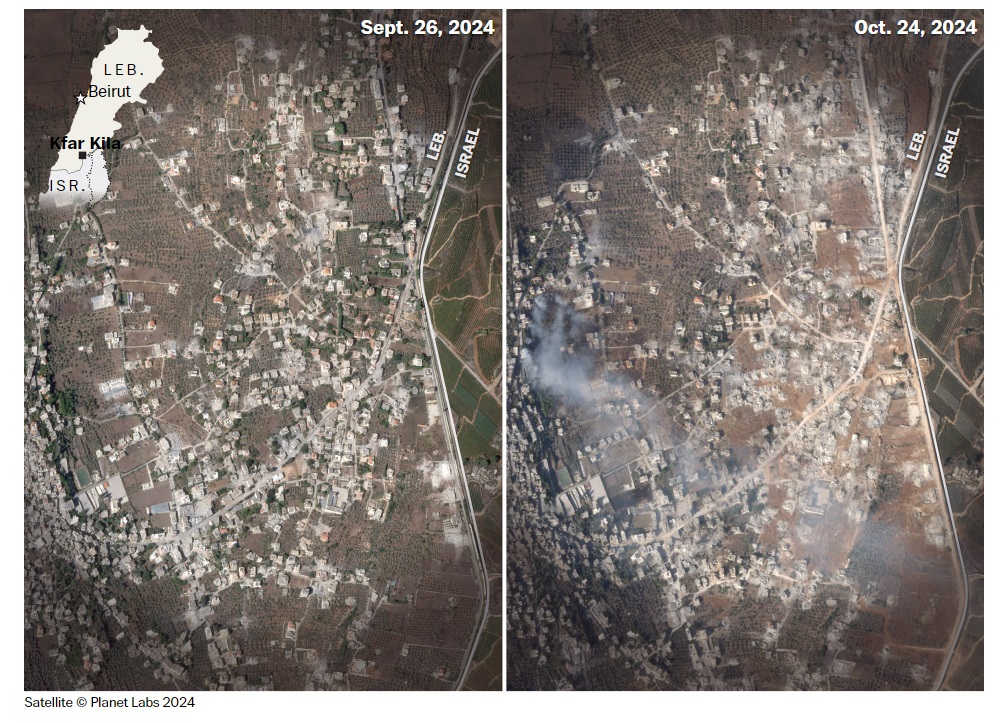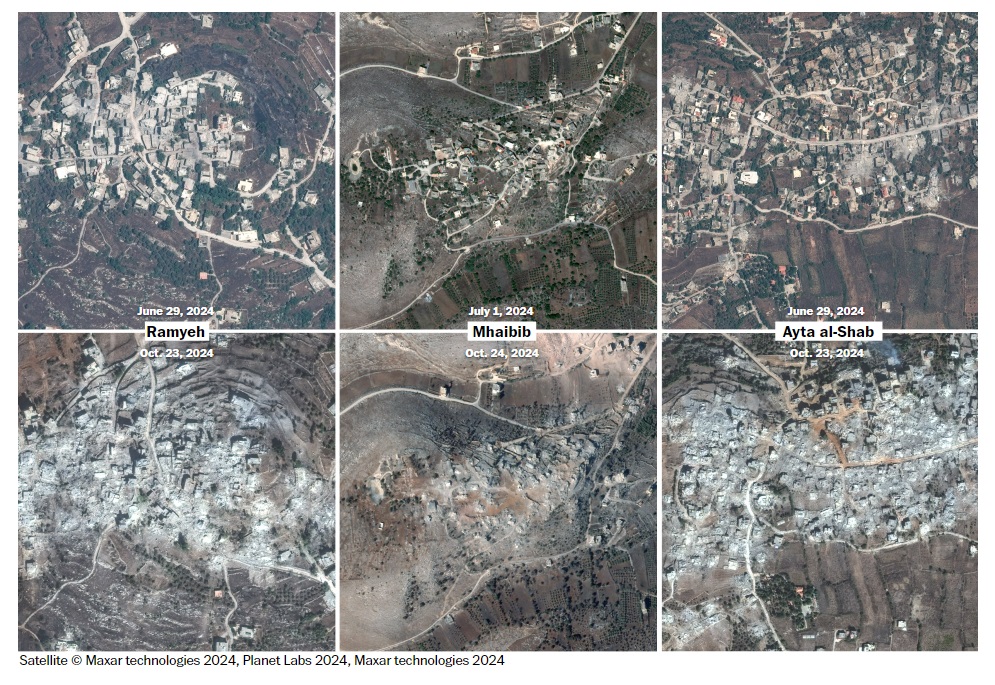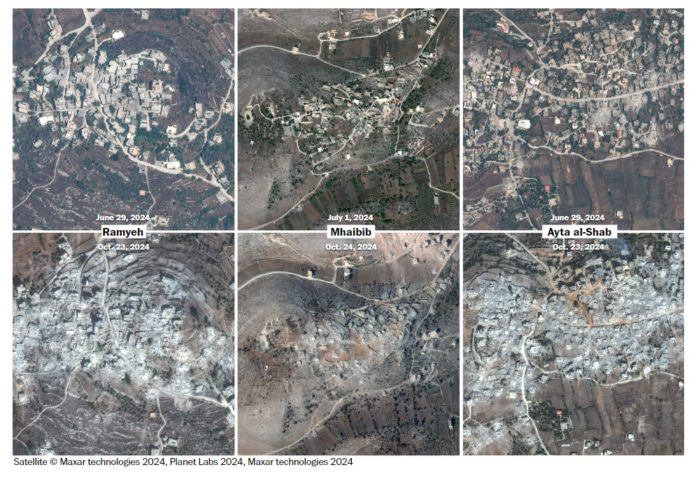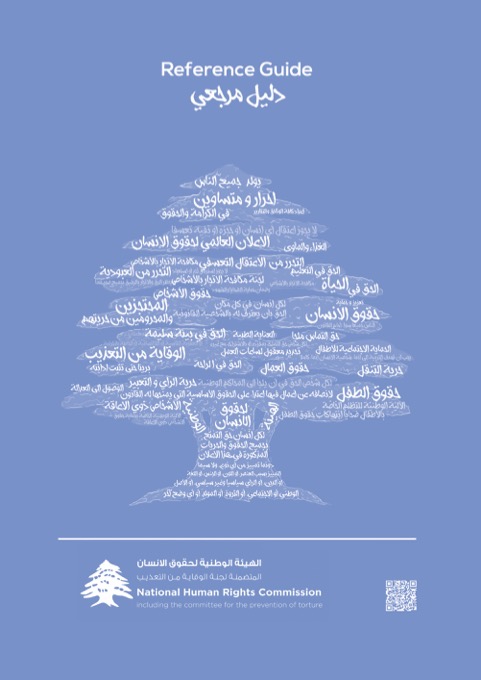هذه المقالة متاحة أيضًا بـ: العربية (Arabic)
More than 5,000 structures have been affected in border villages, including at least nine religious sites demolished in controlled explosions, a Post analysis found.
The Post reached its findings by reviewing satellite imagery from southern Lebanon, verifying videos and obtaining an analysis of Sentinel-1 satellite radar data. In addition to the visible destruction wrought by Israeli airstrikes and intensifying ground battles, the videos show more than a dozen controlled demolitions carried out by the Israeli military, damaging or destroying at least nine religious sites.
The analysis of Sentinel data, provided by Corey Scher of CUNY Graduate Center and Jamon Van Den Hoek of Oregon State University, allowed The Post to quantify and map the devastation in the south.
The Israel Defense Forces did not comment on the findings in this story. In a statement to The Post, it said its forces are “conducting localized, limited, targeted raids based on precise intelligence” to allow some 60,000 displaced Israelis to return to their homes in the north and remove the threat posed by Hezbollah.
Since the start of the invasion, “the IDF has uncovered the scale and scope of Hezbollah’s attack infrastructure, including vast underground tunnels and huge stockpiles of weapons, embedded along the border in southern Lebanon and pre-positioned to attack Israeli communities,” the statement said, adding that Hezbollah “deliberately embedded these assets in civilian homes and villages.”
The ever-expanding war has touched nearly every part of Lebanon and forced about 1 in 5 people from their homes.
“The use of explosive weapons in urban areas, either from direct targeting with air and artillery strikes or controlled detonation, is rendering large parts of the south uninhabitable,” said Wim Zwijnenburg, a project lead at PAX, a Dutch organization that focuses on the protecting civilians in war.
A pattern of destruction
The ancient villages of southern Lebanon are carved into hillsides, with names that date back to the Bronze Age. In these small communities, daily lives and traditions are tied to the land, and to cultivating the olive groves and tobacco fields that blanket the border.
After multiple wars with Israel, many of the villages along the border in the Shiite-majority south are supportive of Hezbollah, and the group exercises control in some areas. But the region also includes towns with sizable Christian, Druze and Sunni Muslim populations, where Hezbollah has less influence.
“This systematic destruction is threatening not just the livelihoods of people from this area but the cultural identity of the region,” said Hisham Younes, director of Green Southerners, an environmental group that focuses on southern Lebanon. “They are trying to break the link between the people and their land.”
Kfar Kila was among the first places where Israeli troops crossed the border, with tracks from military vehicles visible in satellite imagery as early as Oct. 3. By Saturday, at least 46 percent of the buildings in the town had been damaged or destroyed, according to The Post’s analysis of the satellite radar data.
Before the war, the village’s olive groves were lush and the markets bustled with crowds from neighboring towns, said Khodor Serhan, 62, a renowned soap maker and Kfar Kila native. He doesn’t know if his home and his factory are still standing; he can’t bring himself to look at the images of devastation from above.

“It’s better not to,” said Serhan, speaking by phone from the Chouf Mountains, where he is staying after his second round of displacement in the past 10 months. “In this war, what is standing today is no indication that it will be standing tomorrow.”
Satellite imagery from Kfar Kila shows freshly turned soil where olive groves once stood, suggesting a clearance operation by Israeli forces. Dozens of crushed buildings line the town’s main road. The destruction is most intense near the Israeli border.
The village centers in nearby Ayta al-Shab, Mhaibib and Ramyeh have also been decimated, the imagery reveals.

Videos published on social media show a series of controlled explosions in at least 11 villages.
In a video published to X on Oct. 22, half a dozen buildings fall in an instant after an explosion, covering the 400-year-old village of Ayta al-Shab in dust clouds and debris. In drone footage published online the next day, an Israeli flag flies over the town — now reduced to a sea of broken trees and collapsed concrete.
Most of the demolitions there appear to have begun on or around Oct. 14. From Oct. 16 to at least Sunday, the Golani Brigade, which first entered Lebanon on Oct. 2, was active in and around Ayta al-Shab, according to videos released by the IDF. The brigade deployed to Gaza last year and was tied in Israeli media to a series of controversial demolitions in the north of the enclave.
The number of buildings damaged or destroyed in the village tripled while the brigade was active in Ayta al-Shab, according to The Post’s analysis of the data provided by Scher and Van Den Hoek. By Saturday, nearly half of the village lay in ruins.
Israeli forces appear to have made little effort to spare religious sites, and in some cases have reveled in their destruction.
About two miles away, in the village of Ramyeh, a video geolocated by The Post shows soldiers celebrating a controlled demolition that included the village mosque. Two gray plumes of smoke cascade into the air.
In another verified video, shot near the concrete wall separating Israel from Lebanon, an Israeli soldier films a mosque in the village of Dhayra. When he gives the all-clear, the towering minaret sinks, along with the surroundings buildings, into a pile of dust.
“What a moment!” the soldier says. Others around him break into a religious song.
In Meiss el Jabal, about 28 percent of the town’s buildings, more than 900 in total, have been damaged or destroyed.
“Everything has been reduced to rubble,” said Fatima Ghoul, who was born and raised in the village of 8,000 people. “No homes, no shops, nothing but dust where life once thrived.”
At least two of the village’s three mosques were also destroyed, a review of satellite imagery shows. Cultural property, including religious buildings, is given special status under international law.
“Even if civilians are not inside, those types of buildings don’t lose their protection,” said Sarah Harrison, a former Defense Department attorney who advised the United States on the laws of armed conflict. The buildings would only lose their protected status, she said, if Hezbollah fighters were actively operating from inside them.
The IDF has said the large demolitions target tunnels that support Hezbollah’s military wing. If a protected building is built on top of a tunnel used for military purposes, the potential damage to the building must be taken into consideration before the attack, Harrison said.
“The IDF continues to operate in strict accordance with international law and under the directive of the political echelon,” the Israeli military said in its statement to The Post.
The pattern of destruction along the length of the border is evidence that Israel is systematically clearing Lebanese border communities to counter any future threats, according to Nicholas Blanford, a Beirut-based Hezbollah expert with the Atlantic Council.
“The actions seem more focused than in 2006,” Blanford said, referring to the last war between Israel and Hezbollah. “This time around, the destruction seems to be more systematic and focused on border villages which Hezbollah could potentially use as staging grounds for cross-border incursions.”
Serhan, the soap maker from Kfar Kila, said that “only a few houses were destroyed in 2006.” Now, he said, “What I hear is that nothing in the village has been spared.”


